1151
Citrus topic
Good day, dear.
In this cold harsh days when it seems that we have forgotten about the spring and summer will never come back, these small and very yellow, green, orange balls very uplifting.
I do not know about you, I was even on the species in the photo gets a bit warmer ...
25 photos + text
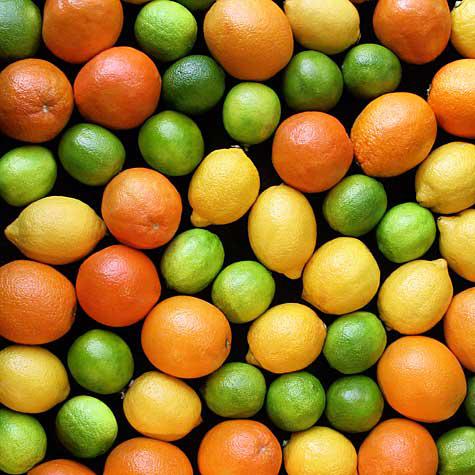
What kind of fruit trees can be compared to citrus! Shiny, evergreen foliage, dark and dense. The white fragrant flowers that bloom one after another, almost all year round, such as lemon tree. The fruits, rich in vitamins, as beautiful as delicious and healthy. Fruits, painted all shades from pale lemon yellow to bright orange color orange, and varied in size, ranging from small, like a pigeon's egg, fruit kinkala to large as a child's head, and pummelos Cedri. Variety and taste them - from very sweet to sour lemon tangerine and grapefruit to their complicated bitter-sweet-sour taste.

Durability of citrus trees is amazing. For example, orange trees can live to be 600 - 700 years (usually 100 years).
Even more surprising their productivity. In the subtropics known Georgian tangerine trees, bringing to 7,000 fruits per year. To the south of Batumi is the old orange tree-giant harvests which reach 9000 fruits.
In citrus trees are used not only fruits, but also all the waste, all parts of the plant. Are removed when pruning the leaves and twigs, falling flowers, fruits, and ovary, inedible fruit peel, it's - the raw material for the precious essential oils used in perfumery and confectionery. Even the seeds of the fruit used in recent years for medicinal purposes. Finally, the wood is used as a citrus high-value ornamental material.
What other fruit trees, you can find a combination of these qualities! In Russian folklore fabulous "golden apples" rip off the Firebird, are an echo of the rumors about the healing of citrus fruit far south, known only by hearsay.
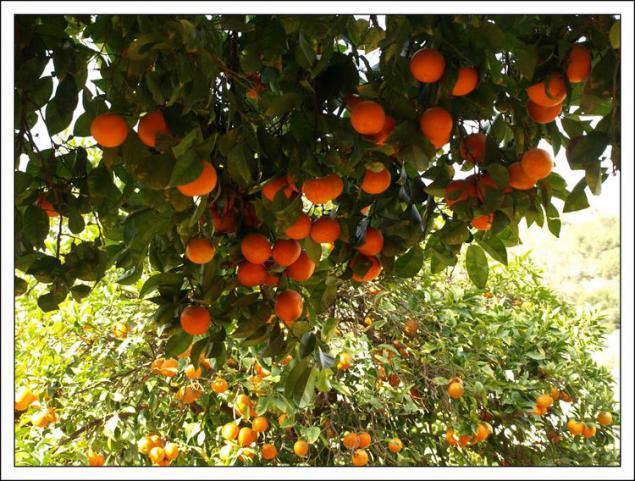
Orange
This wonderful fruit has appeared in Europe in the early 16th century. The very first tree was grown in Lisbon, and then quickly spread to the oranges of Sicily and Sardinia. In Italy, near the town of Milis, placed a huge orange forest where growing now about 600 thousand trees.
Of all the citrus orange firmly holds the worldwide first place both in area and yield.

Oranges include most of biologically active substances. These substances beneficial effect on the organism. At orange high levels of sugar. Depending on the sort of the last number ranging from 7 to 11%, of which a significant percentage of fructose and glucose. Just rich oranges and ascorbic acid, essential oils, which are much smaller in the flesh than in the skin. This fruit is extremely high in potassium, magnesium, klechatki. Very important place is given to bioflavonoids, which regulate the growth of the organism, have an antioxidant effect.
Orange stimulates the appetite perfectly, is important as a general tonic. The vital necessity of a fruit a lot of different vitamins, biologically active substances, this citrus is recommended for the prevention and treatment of hypovitaminosis, helps digestion, diseases of the cardiovascular system. Contraindications only for patients with gastritis, gastric ulcer, as the essential oils irritate the stomach lining.
It is no secret that the orange has a health effect on the skin, of course, if they are not abused. If orange juice is applied directly to the skin, the effect of it will be much more effective. In the old days people have learned to treat such disease orange as scurvy.

If we take the total number of species and varieties of oranges, even those that are purely economic values, one topic for consideration is not enough, because the oranges are so many varieties that it is simply impossible to count them. For example, the most common view in Russia recognized oranges imported from Turkey and Morocco. From there come such varieties of oranges, as "Valencia" and "Washington Neville. Experts say that the difference between oranges imported from Turkey or Morocco to the taste or appearance of the impossible.

Lemon
This acidic fruit has unique medical and therapeutic properties. Even in ancient Greece, women take care of their health and beauty, using lemon. It's no secret that in the lemon rich in vitamin C. But it's not all his benefits. It contains large amounts of vitamin P, pectin, essential oils, terperin and bioflavonoids which strengthen capillary walls. Generally, if you list all the macro-and micronutrients, get an impressive list.
Another interesting fact is that despite the fact that this acidic fruit, it does not increase the acidity in the stomach but rather lowers. So contraindications have not observed a lemon.
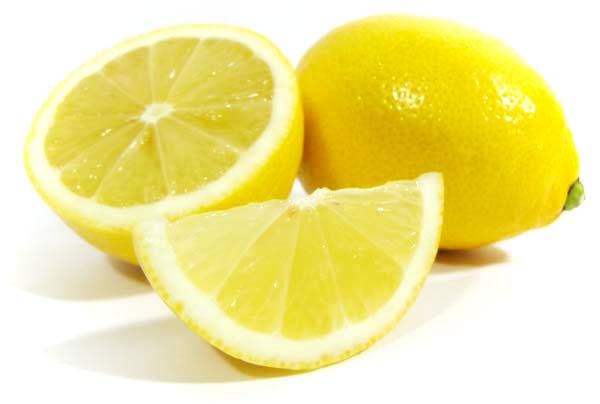
Lemon tree can reach a height of 10 meters (33 feet), while the average tree is generally smaller. The branches are thorny, and form an open crown. The leaves are green, shiny and sharp. Flowers are white with purple outside of the inner layer and have a strong flavor. Fruits grow under the flowers. When the flower petals fall, the little green embryo is left behind, and to ripen the fruit. In healthy lemon tree, flowers and ripe fruit can often be found at one and the same time.

Mention of lemon in the literature dates back to the Arabic treatise of the tenth century on agriculture, although it probably first cultivated in Assam, India. Lemon is used as an ornamental plant in early Islamic gardens. Lemonade possibly invented in medieval Egypt.
The average lemon contains approximately 3 tablespoons of juice. Lemons warming to room temperature before compression (or brief heating in a microwave oven) facilitates the extraction of the juice. Lemons left non-refrigerated for long periods of time are susceptible to mold.
There are many varieties of lemon: Eureka, which is more likely to be found on sale, Lisbon lemon (Lisbon lemon), which is smaller in size than the Eureka, and sleeker, lemon Meyer (Meyer lemon), which is becoming increasingly popular for its more pleasant taste. The replaced: in cakes - grapefruit, soups and marinades - lemongrass (lemongrass), the rest - lime or citron, if you want to just peel and peel.

Lime
Lime has a reputation for close friend of lemon, lime but - more useful than a lemon. This evergreen plant grows mainly in Mexico and the Indian islands. This nickname lime, has roots from the Persian name of lemon - lemon. Lime is reputed to dark green leaves and is very popular across the perfect flavor. Torn or chopped lime leaves are often added to food to impart a spicy flavor. Zest is cut and attached to the sauces, and the flesh is often used in cooking. Very often, this exotic fruit is popular in the confectionery business.

As with all citrus lime includes vitamin C and potassium. Ascorbic acid is also a useful component of this fruit. As you know, these components are an excellent medicine against heart disease and, of course, the vessels. It is an excellent anti-depressant, and is an excellent bactericidal agent. Those who suffer from headaches and alcoholism, it is an excellent tool for therapy. Using lime can also be rejuvenated because it activates dermal cells. And about wrinkles you do forget to think when properly used this fruit. In dentistry lime reputed major supplier of calcium and phosphorus in the body. This means that you can prevent dental disease, as well as protect against periodontitis. This fruit has also organic acids, which can serve as excellent dental bleaches. Besides this source of nutrients is pectin, which is essential for intestinal and digestive system. And essential oils, which is also a constituent of the fruit, increase appetite and function of digestion. It is also indispensable for those who suffer from nervous disorders. Lime should be served fresh to the table, as he tends to lose the function of healing, and sometimes even taste.

There are many varieties of lime:
Sweet Lime (Citrus latifolia Tanaka). Its fruits resemble a lemon, they are large (6-8 cm in diameter), with a thin (1 to 5 mm), smooth-skinned. The aroma is weaker than that of the lime. Usually seedless fruit is similar in composition with lime present. Fruit sweet lime (Citrus limettioides Tanaka) contain no acid, fresh sugars in the juice to 6%. It is widely used in folk medicine, particularly malaria.
Rangpur Lime (Citrus limonia Osbeck) is used as a rootstock citrus crops. In some countries it is cultivated for fruit. The fruit acid, about 5 cm in diameter, peel thin, easily separated. The peel and the flesh is dark orange. For Rangpur lime characteristic of drought resistance, high yield.
Mexico (syn. West Indies), small fruits. This grade is the most widely used to produce oil by squeezing fruit or long-term (10 - 16 hours) steam stripping.
There are such hybrids as limonaymy (lime × lemon) Limequat (x kumquat lime), and others.
And the plague of limes, perhaps, is the Australian finger lime (finger lime). It is also called citrus caviar. Because the flesh of Australian lime looks like this:
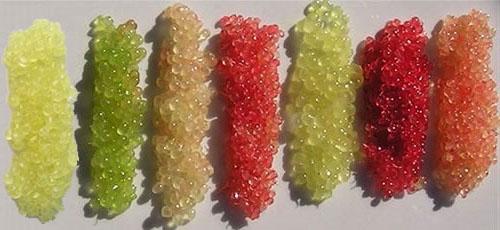
Mandarin
Homeland of the fruit, the sun is China, it's just no question. Fruit got its name for the same reason that in the old days was available wealthy Chinese - Mandarin. He argued that Europe saw the first mandarin trees only in the early nineteenth century. And it is only because they have been brought as a gift to the great Napoleon. We have for a long time they were not ubiquitous, they could get only the rich. Luck was believed if children from poor families have tried to cover this fragrant fruit. I wonder though, what tangerine peel is considered useful elements richer than the flesh.
This fruit has a reputation of vitamins and organic acids. Fruits include potassium, calcium, which promote proper metabolism. The presence of beta-carotene prevents the formation of cancer, and vitamin K in a friendly tone of vessels. Very useful tangerine juice, especially asthmatics and bronchitis. But for smokers, it is a great help to cleanse the lungs of mucus.

In Russia, all thin-skinned orange-red citrus, smaller oranges, tangerines name. Meanwhile, there are many varieties of mandarins bright orange color with a special sweet taste. All tangerines, tangerine and tangelo (a hybrid of tangerine with a grapefruit) is easy to clean and pleasant to eat. Satsuma mandarin - sweet seedless mandarin orange, often used for the production of canned mandarins. Once Satsuma tangerines brought from Japan. Satsuma - in Japan, known for producing the finest porcelain. Satsuma mandarins are very tender, with the trees they cut carefully, so that the market is sometimes sold with the branches (cuttings) and leaves.
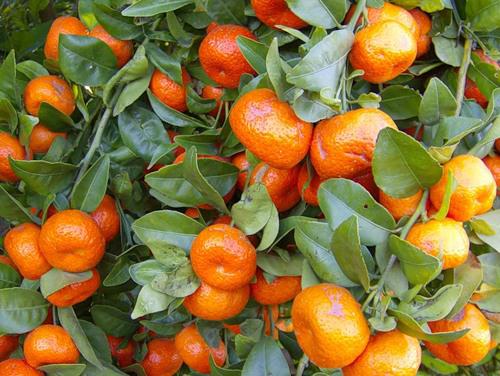
Clementine - a hybrid of a tangerine and an orange-wren of subspecies bigarage, created in 1902 by a French priest and breeder father Clement.
Tangerine. In the US, called Tangerine all citrus fruits with loose skin. In fact tangerine - this is just one of the types of mandarins. Here are some of the most popular varieties. Ballroom tangerine - something with which the United States is associated Christmas with sweet and sour taste, there are many bones, and dark reddish-orange peel with him if she is removed. Honey tangerine is rich in sugar, which gives it a sweet, juicy flavor characteristic aroma. Fruit yellowish orange, full of juice, with a thin smooth skin. Minneolsky tangerine - the fruit produced by crossing tangerine and grapefruit, it is easy to find on the large size and slightly elongated "neck" at one end.

Grapefruit - a subtropical citrus tree grown for its fruit which was originally called "forbidden fruit" of Barbados. These evergreen trees are usually in the range of 5-6 m tall, although they can reach and 13-15 m.
Grapefruit was known as the shaddock or shaddock until the 1800s. Its current name refers to a group of fruit on the tree, which often appear similar to grapes. Botanically, the fruit does not differ from the pomelo until 1830, when it was given the name Citrus paradizi. Its true origin was not identified until 1940. This led to the fact that its official name was changed to Citrus paradise.

Grapefruit - an excellent source of many nutrients and phytochemicals for a healthy diet. Grapefruit - a good source of vitamin C, pectin fiber, and the pink and red grapefruit contain lycopene good antioxidant. Studies have shown that grapefruit helps lower cholesterol and there is evidence that its seeds have low levels of antioxidant properties. Grapefruit is a major part of the "grapefruit diet", the theory proves that a low glycemic index of these fruits are able to increase the body's metabolism and burn fat.
There are about 20 varieties of grapefruit, which can be divided into two main groups: white (or yellow) grapefruit, with pulp zhёltovatogo shade, and red. Moreover, the more red grapefruit pulp otenkom contains, the sweeter it is. American cultivar with red pulp Ruby was patented in 1952. From him there were other red varieties developed primarily in Texas. Of these, the most popular on the market received a variety Rio Red, Star Ruby and Flame. There are varieties with lots of seeds in the fruit, as well as completely devoid of them.

Pomelo
The roots of the broom are also Chinese direction. In China, until now hovering legend that this fruit gives to the welfare and prosperity of the house provides. In Europe, he arrived in the XIV century and the perpetrators of the Portuguese, but then he did not become very popular. But the wide distribution it has reached after many years, but only this time in Central America. Captain Shedok took care of the delivery of this noble fruit on the shores of this continent. Here it is called often Shedokom, on behalf of the great revealer, we have it known as pomelo or shaddock.
Pomelo has a pale green color, and if it is a mature fruit that reaches yellow. The size of a grapefruit, he surpasses even that is small it can not be called. The weight of the fruit may even exceed several kilograms, and it tastes pleasantly sweet. There are cases where Shedok grows to about 10 kilograms, you will agree, is not enough. Now it is widely distributed in California, Taiwan, India, Israel.

The pulp from the pomelo boasts coloring in three colors - white, green, red. Red fruit often tastes like precious grapefruit and green, in turn, have a taste of pine. It is in appearance, like a brother grapefruit, but the taste is similar to golden orange. It is inherent in a very thick skin and very often styled jerunga. Keep pace with these giant fruits directly to Chinese New Year, that is, by February. The Chinese are used to give the fruit on their holiday as a symbol of prosperity and well-being. This plant has a specific mystical sense, but also a great sweet taste.

Bergamot
The sign of a good flavoring teas. Many people believe that flavored tea bergamot pear. But this is not so, because the pear only chut-hardly gives a similar flavor. As an advocate of citrus fruits flavor plant Bergamote (bergamot) with sour and slightly gorchaschey pulp.
Bergamot - it is a hybrid produced by crossing sweet oranges and lemons. However, Bergamot is one of the oldest species of citrus and distinguished as a separate species. They got their name from the Italian city of Bergamo in Lombardy. Today bergamot grown mainly in southern Italian Calabria.
The fruits have a diameter of 5 - 7 cm and painted yellow. The flesh is green. They are the result of cross-breeding orange and citron. The fruits are grown primarily for producing essential oils. Bergamot oil - is the basis of many fragrances, used in the manufacture of perfumes, and added to teas, for example, gives a unique flavor famous tea, Earl Grey, and also liqueurs Curaçao.

Tangelos
It is a hybrid between a tangerine and any other citrus fruit (there are many varieties of this fruit). For example, Mineola is a hybrid of tangerine and grapefruit, very popular variety. Replaced with oranges, grapefruit, tangerines.
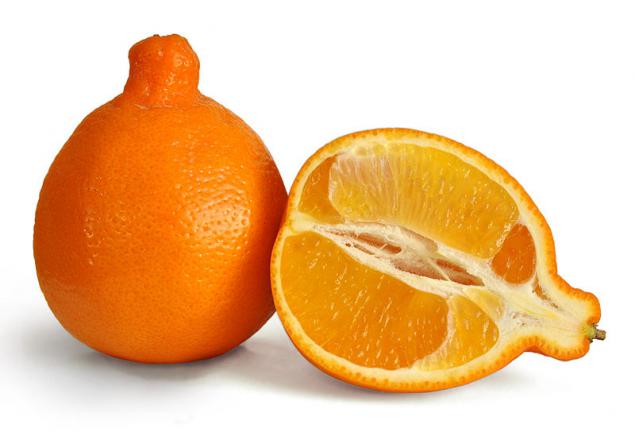
Kumquat
Source:
In this cold harsh days when it seems that we have forgotten about the spring and summer will never come back, these small and very yellow, green, orange balls very uplifting.
I do not know about you, I was even on the species in the photo gets a bit warmer ...
25 photos + text

What kind of fruit trees can be compared to citrus! Shiny, evergreen foliage, dark and dense. The white fragrant flowers that bloom one after another, almost all year round, such as lemon tree. The fruits, rich in vitamins, as beautiful as delicious and healthy. Fruits, painted all shades from pale lemon yellow to bright orange color orange, and varied in size, ranging from small, like a pigeon's egg, fruit kinkala to large as a child's head, and pummelos Cedri. Variety and taste them - from very sweet to sour lemon tangerine and grapefruit to their complicated bitter-sweet-sour taste.

Durability of citrus trees is amazing. For example, orange trees can live to be 600 - 700 years (usually 100 years).
Even more surprising their productivity. In the subtropics known Georgian tangerine trees, bringing to 7,000 fruits per year. To the south of Batumi is the old orange tree-giant harvests which reach 9000 fruits.
In citrus trees are used not only fruits, but also all the waste, all parts of the plant. Are removed when pruning the leaves and twigs, falling flowers, fruits, and ovary, inedible fruit peel, it's - the raw material for the precious essential oils used in perfumery and confectionery. Even the seeds of the fruit used in recent years for medicinal purposes. Finally, the wood is used as a citrus high-value ornamental material.
What other fruit trees, you can find a combination of these qualities! In Russian folklore fabulous "golden apples" rip off the Firebird, are an echo of the rumors about the healing of citrus fruit far south, known only by hearsay.

Orange
This wonderful fruit has appeared in Europe in the early 16th century. The very first tree was grown in Lisbon, and then quickly spread to the oranges of Sicily and Sardinia. In Italy, near the town of Milis, placed a huge orange forest where growing now about 600 thousand trees.
Of all the citrus orange firmly holds the worldwide first place both in area and yield.

Oranges include most of biologically active substances. These substances beneficial effect on the organism. At orange high levels of sugar. Depending on the sort of the last number ranging from 7 to 11%, of which a significant percentage of fructose and glucose. Just rich oranges and ascorbic acid, essential oils, which are much smaller in the flesh than in the skin. This fruit is extremely high in potassium, magnesium, klechatki. Very important place is given to bioflavonoids, which regulate the growth of the organism, have an antioxidant effect.
Orange stimulates the appetite perfectly, is important as a general tonic. The vital necessity of a fruit a lot of different vitamins, biologically active substances, this citrus is recommended for the prevention and treatment of hypovitaminosis, helps digestion, diseases of the cardiovascular system. Contraindications only for patients with gastritis, gastric ulcer, as the essential oils irritate the stomach lining.
It is no secret that the orange has a health effect on the skin, of course, if they are not abused. If orange juice is applied directly to the skin, the effect of it will be much more effective. In the old days people have learned to treat such disease orange as scurvy.

If we take the total number of species and varieties of oranges, even those that are purely economic values, one topic for consideration is not enough, because the oranges are so many varieties that it is simply impossible to count them. For example, the most common view in Russia recognized oranges imported from Turkey and Morocco. From there come such varieties of oranges, as "Valencia" and "Washington Neville. Experts say that the difference between oranges imported from Turkey or Morocco to the taste or appearance of the impossible.

Lemon
This acidic fruit has unique medical and therapeutic properties. Even in ancient Greece, women take care of their health and beauty, using lemon. It's no secret that in the lemon rich in vitamin C. But it's not all his benefits. It contains large amounts of vitamin P, pectin, essential oils, terperin and bioflavonoids which strengthen capillary walls. Generally, if you list all the macro-and micronutrients, get an impressive list.
Another interesting fact is that despite the fact that this acidic fruit, it does not increase the acidity in the stomach but rather lowers. So contraindications have not observed a lemon.

Lemon tree can reach a height of 10 meters (33 feet), while the average tree is generally smaller. The branches are thorny, and form an open crown. The leaves are green, shiny and sharp. Flowers are white with purple outside of the inner layer and have a strong flavor. Fruits grow under the flowers. When the flower petals fall, the little green embryo is left behind, and to ripen the fruit. In healthy lemon tree, flowers and ripe fruit can often be found at one and the same time.

Mention of lemon in the literature dates back to the Arabic treatise of the tenth century on agriculture, although it probably first cultivated in Assam, India. Lemon is used as an ornamental plant in early Islamic gardens. Lemonade possibly invented in medieval Egypt.
The average lemon contains approximately 3 tablespoons of juice. Lemons warming to room temperature before compression (or brief heating in a microwave oven) facilitates the extraction of the juice. Lemons left non-refrigerated for long periods of time are susceptible to mold.
There are many varieties of lemon: Eureka, which is more likely to be found on sale, Lisbon lemon (Lisbon lemon), which is smaller in size than the Eureka, and sleeker, lemon Meyer (Meyer lemon), which is becoming increasingly popular for its more pleasant taste. The replaced: in cakes - grapefruit, soups and marinades - lemongrass (lemongrass), the rest - lime or citron, if you want to just peel and peel.

Lime
Lime has a reputation for close friend of lemon, lime but - more useful than a lemon. This evergreen plant grows mainly in Mexico and the Indian islands. This nickname lime, has roots from the Persian name of lemon - lemon. Lime is reputed to dark green leaves and is very popular across the perfect flavor. Torn or chopped lime leaves are often added to food to impart a spicy flavor. Zest is cut and attached to the sauces, and the flesh is often used in cooking. Very often, this exotic fruit is popular in the confectionery business.

As with all citrus lime includes vitamin C and potassium. Ascorbic acid is also a useful component of this fruit. As you know, these components are an excellent medicine against heart disease and, of course, the vessels. It is an excellent anti-depressant, and is an excellent bactericidal agent. Those who suffer from headaches and alcoholism, it is an excellent tool for therapy. Using lime can also be rejuvenated because it activates dermal cells. And about wrinkles you do forget to think when properly used this fruit. In dentistry lime reputed major supplier of calcium and phosphorus in the body. This means that you can prevent dental disease, as well as protect against periodontitis. This fruit has also organic acids, which can serve as excellent dental bleaches. Besides this source of nutrients is pectin, which is essential for intestinal and digestive system. And essential oils, which is also a constituent of the fruit, increase appetite and function of digestion. It is also indispensable for those who suffer from nervous disorders. Lime should be served fresh to the table, as he tends to lose the function of healing, and sometimes even taste.

There are many varieties of lime:
Sweet Lime (Citrus latifolia Tanaka). Its fruits resemble a lemon, they are large (6-8 cm in diameter), with a thin (1 to 5 mm), smooth-skinned. The aroma is weaker than that of the lime. Usually seedless fruit is similar in composition with lime present. Fruit sweet lime (Citrus limettioides Tanaka) contain no acid, fresh sugars in the juice to 6%. It is widely used in folk medicine, particularly malaria.
Rangpur Lime (Citrus limonia Osbeck) is used as a rootstock citrus crops. In some countries it is cultivated for fruit. The fruit acid, about 5 cm in diameter, peel thin, easily separated. The peel and the flesh is dark orange. For Rangpur lime characteristic of drought resistance, high yield.
Mexico (syn. West Indies), small fruits. This grade is the most widely used to produce oil by squeezing fruit or long-term (10 - 16 hours) steam stripping.
There are such hybrids as limonaymy (lime × lemon) Limequat (x kumquat lime), and others.
And the plague of limes, perhaps, is the Australian finger lime (finger lime). It is also called citrus caviar. Because the flesh of Australian lime looks like this:

Mandarin
Homeland of the fruit, the sun is China, it's just no question. Fruit got its name for the same reason that in the old days was available wealthy Chinese - Mandarin. He argued that Europe saw the first mandarin trees only in the early nineteenth century. And it is only because they have been brought as a gift to the great Napoleon. We have for a long time they were not ubiquitous, they could get only the rich. Luck was believed if children from poor families have tried to cover this fragrant fruit. I wonder though, what tangerine peel is considered useful elements richer than the flesh.
This fruit has a reputation of vitamins and organic acids. Fruits include potassium, calcium, which promote proper metabolism. The presence of beta-carotene prevents the formation of cancer, and vitamin K in a friendly tone of vessels. Very useful tangerine juice, especially asthmatics and bronchitis. But for smokers, it is a great help to cleanse the lungs of mucus.

In Russia, all thin-skinned orange-red citrus, smaller oranges, tangerines name. Meanwhile, there are many varieties of mandarins bright orange color with a special sweet taste. All tangerines, tangerine and tangelo (a hybrid of tangerine with a grapefruit) is easy to clean and pleasant to eat. Satsuma mandarin - sweet seedless mandarin orange, often used for the production of canned mandarins. Once Satsuma tangerines brought from Japan. Satsuma - in Japan, known for producing the finest porcelain. Satsuma mandarins are very tender, with the trees they cut carefully, so that the market is sometimes sold with the branches (cuttings) and leaves.

Clementine - a hybrid of a tangerine and an orange-wren of subspecies bigarage, created in 1902 by a French priest and breeder father Clement.
Tangerine. In the US, called Tangerine all citrus fruits with loose skin. In fact tangerine - this is just one of the types of mandarins. Here are some of the most popular varieties. Ballroom tangerine - something with which the United States is associated Christmas with sweet and sour taste, there are many bones, and dark reddish-orange peel with him if she is removed. Honey tangerine is rich in sugar, which gives it a sweet, juicy flavor characteristic aroma. Fruit yellowish orange, full of juice, with a thin smooth skin. Minneolsky tangerine - the fruit produced by crossing tangerine and grapefruit, it is easy to find on the large size and slightly elongated "neck" at one end.

Grapefruit - a subtropical citrus tree grown for its fruit which was originally called "forbidden fruit" of Barbados. These evergreen trees are usually in the range of 5-6 m tall, although they can reach and 13-15 m.
Grapefruit was known as the shaddock or shaddock until the 1800s. Its current name refers to a group of fruit on the tree, which often appear similar to grapes. Botanically, the fruit does not differ from the pomelo until 1830, when it was given the name Citrus paradizi. Its true origin was not identified until 1940. This led to the fact that its official name was changed to Citrus paradise.

Grapefruit - an excellent source of many nutrients and phytochemicals for a healthy diet. Grapefruit - a good source of vitamin C, pectin fiber, and the pink and red grapefruit contain lycopene good antioxidant. Studies have shown that grapefruit helps lower cholesterol and there is evidence that its seeds have low levels of antioxidant properties. Grapefruit is a major part of the "grapefruit diet", the theory proves that a low glycemic index of these fruits are able to increase the body's metabolism and burn fat.
There are about 20 varieties of grapefruit, which can be divided into two main groups: white (or yellow) grapefruit, with pulp zhёltovatogo shade, and red. Moreover, the more red grapefruit pulp otenkom contains, the sweeter it is. American cultivar with red pulp Ruby was patented in 1952. From him there were other red varieties developed primarily in Texas. Of these, the most popular on the market received a variety Rio Red, Star Ruby and Flame. There are varieties with lots of seeds in the fruit, as well as completely devoid of them.

Pomelo
The roots of the broom are also Chinese direction. In China, until now hovering legend that this fruit gives to the welfare and prosperity of the house provides. In Europe, he arrived in the XIV century and the perpetrators of the Portuguese, but then he did not become very popular. But the wide distribution it has reached after many years, but only this time in Central America. Captain Shedok took care of the delivery of this noble fruit on the shores of this continent. Here it is called often Shedokom, on behalf of the great revealer, we have it known as pomelo or shaddock.
Pomelo has a pale green color, and if it is a mature fruit that reaches yellow. The size of a grapefruit, he surpasses even that is small it can not be called. The weight of the fruit may even exceed several kilograms, and it tastes pleasantly sweet. There are cases where Shedok grows to about 10 kilograms, you will agree, is not enough. Now it is widely distributed in California, Taiwan, India, Israel.

The pulp from the pomelo boasts coloring in three colors - white, green, red. Red fruit often tastes like precious grapefruit and green, in turn, have a taste of pine. It is in appearance, like a brother grapefruit, but the taste is similar to golden orange. It is inherent in a very thick skin and very often styled jerunga. Keep pace with these giant fruits directly to Chinese New Year, that is, by February. The Chinese are used to give the fruit on their holiday as a symbol of prosperity and well-being. This plant has a specific mystical sense, but also a great sweet taste.

Bergamot
The sign of a good flavoring teas. Many people believe that flavored tea bergamot pear. But this is not so, because the pear only chut-hardly gives a similar flavor. As an advocate of citrus fruits flavor plant Bergamote (bergamot) with sour and slightly gorchaschey pulp.
Bergamot - it is a hybrid produced by crossing sweet oranges and lemons. However, Bergamot is one of the oldest species of citrus and distinguished as a separate species. They got their name from the Italian city of Bergamo in Lombardy. Today bergamot grown mainly in southern Italian Calabria.
The fruits have a diameter of 5 - 7 cm and painted yellow. The flesh is green. They are the result of cross-breeding orange and citron. The fruits are grown primarily for producing essential oils. Bergamot oil - is the basis of many fragrances, used in the manufacture of perfumes, and added to teas, for example, gives a unique flavor famous tea, Earl Grey, and also liqueurs Curaçao.

Tangelos
It is a hybrid between a tangerine and any other citrus fruit (there are many varieties of this fruit). For example, Mineola is a hybrid of tangerine and grapefruit, very popular variety. Replaced with oranges, grapefruit, tangerines.

Kumquat
Source:






















